#trade omnibus
Explore tagged Tumblr posts
Text



Shipping February 18th, the BEASTS OF BURDEN OMNIBUS, collecting all four hardcover volumes with all the stories and extras published so far. Includes the Hellboy crossover and three Eisner Award-winning stories/issues. Nearly 600 color pages for only $30. Adopt this book next month!
#comics#dark horse comics#evandorkin#beasts of burden#jill thompson#benjamin dewey#sarah dyer#mike mignola#hellboy#dogs and cats#supernatural#occult evil#nate piekos#jason arthur#cats#dogs#good versus evil#horror#fantasy#adventure#omnibus edition#trade paperback
165 notes
·
View notes
Text
people who read a lot of comics where do you find them. or is my ass just going to have to Purchase that shit
#beep boop#i'll do it but probably only for like well reviewed stuff you can read in omnibus or trade form that i want physically anyway
21 notes
·
View notes
Text
My pull list as of right now:





Notes: Batman isn’t on there cause I’m dropping it after Chip leaves. Also I’m looking for at least two more to drop cause I’ve decided that I have to stick to under 25 pulls a month, and I’d like to go down to 24 or 23 so I have room for a one-shot.
#I’m very financially irresponsible#and I’ve decided to do a low buy next year#but comics is like the one thing I wanna spend money on#(plus upgrading my PC but I’m gonna save for that)#also this doesn’t include trades#I’ve already pre-ordered absolute mister miracle#and the green arrow archers quest omnibus
5 notes
·
View notes
Note
they're releasing a new trade for batgirl (2000) this year just so you know!!! https://leagueofcomicgeeks.com/comic/7756851/dc-finest-batgirl-nobody-dies-tonight-tp
I DID NOT KNOW THIS. the money is in my hand omg dc take it. it’s called nobody dies tonight… you’re actually joking with me… this is so hype. omg im looking at all the dc finest trades being released next year and im actually creaming my pants socially acceptable phrase.
#i feel like this means that they won’t ever be realizing an omnibus#and instead will do 5 different trades#over like five years#which… is fine#and i’m very excited for this#but dc dc i swear you would make so much money selling an omnibus#the people want it#221talks
3 notes
·
View notes
Text

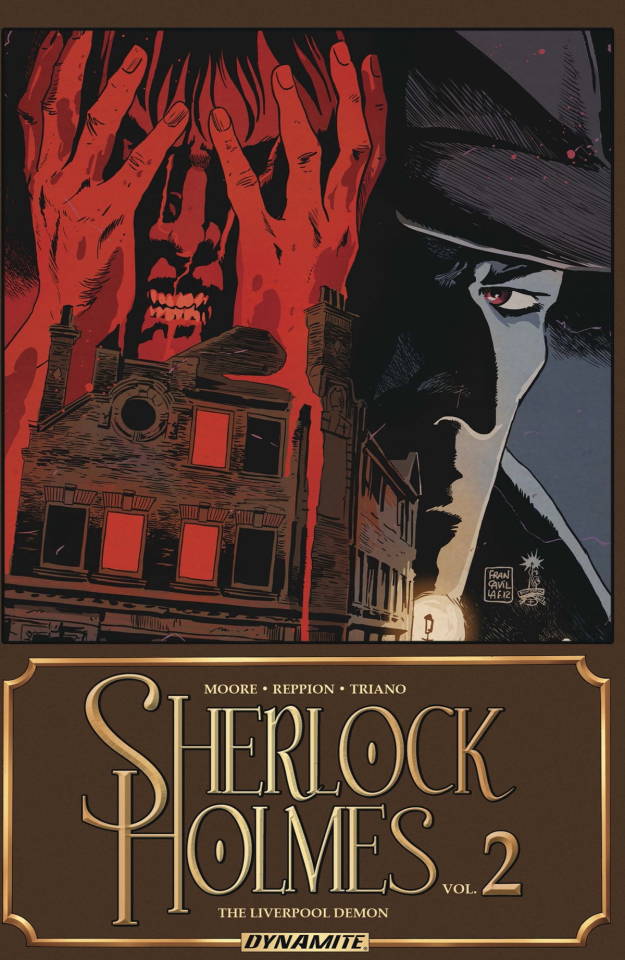

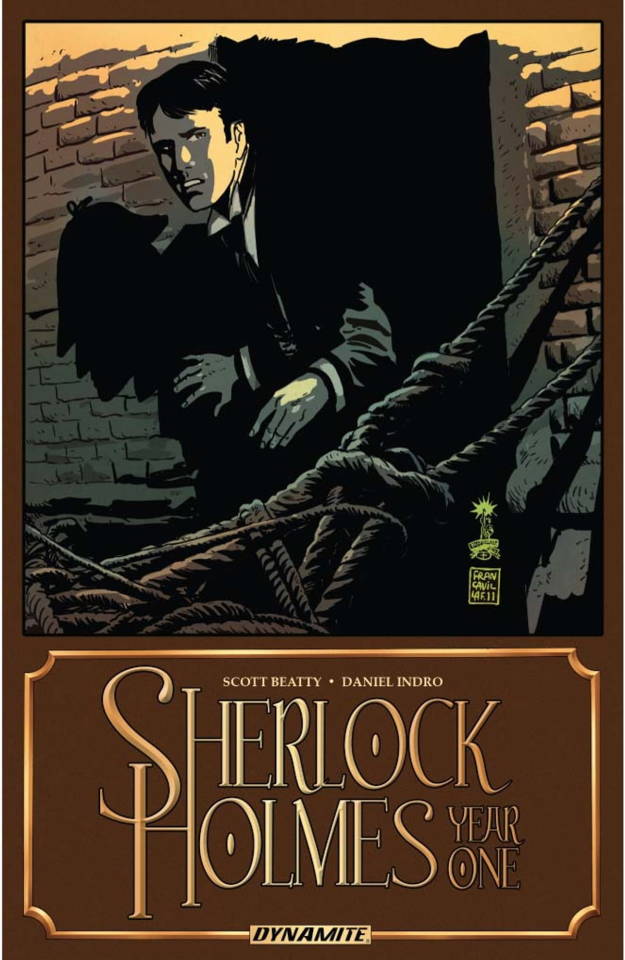
Covers for some of the trade paper back collections of the Dynamite Sherlock Holmes series
#i have the liverpool demon and moriarty lives lol#there's also omnibus#which compiles trial. year one. and liverpool demon#my local comic book store has that but its pricey#i got the ones i have on sale at the same store lol#theres multiple other books also and honestly i cannot tell what order these are supposed to be in because it seems to change#every source says something slightly different#so heres these#ill do another post for the different individual covers i think theyre really cool#sherlock Holmes#holmes#sherlock holmes comic#sherlock holmes comic book#comic books#dynamite comics#dynamite holmes#trade paperback#the trial of sherlock holmes#year one#moriarty lives#the liverpool demon#comics
13 notes
·
View notes
Text
Preview: Weaver Omnibus Trade Paperback
Weaver Omnibus Trade Paperback preview. Born with the uncanny ability to steal other people’s memories, abilities, and expertise for a limited time, Weaver is a man who could change the world #comics #comicbooks
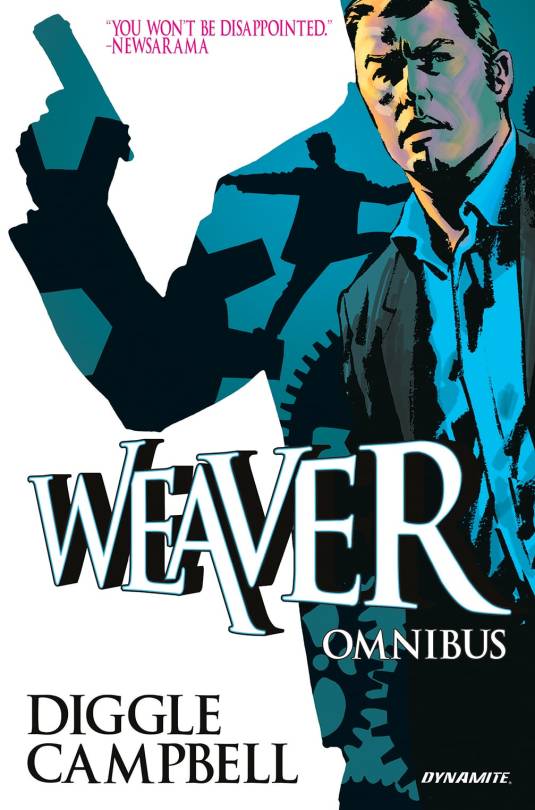
View On WordPress
#aaron campbell#andy diggle#dynamite entertainment#omnibus#sean phillips#trade paperback#trade paperbacks#weaver
0 notes
Note
Hi! Possibly a bit of a weird question for you, but I'm trying to collect all of YW in hardbacks before my old omnibus finally gives out, and I was wondering - do you know if books 1-4 ever got published in hardback with the Harcourt black base/white text cover art? So many websites use blank placeholders that I can't tell if what I'm searching for even exists!
It’s not weird at all. I get occasional inquiries (especially from librarians) about how to get their hands on complete hardcover sets of the Young Wizards books.
Let's make this simpler from the start by establishing that in the forty-plus year history of the series, there has never been a unified hardcover edition of all the YW books, from any of their publishers... mostly because there've been too many publishers over that stretch of time.
Let's take the books in order, as far as possible, and you'll see what happened.
The books' first home was at Delacorte Press, an imprint of Dell Publishing. So You Want To Be A Wizard was published in hardcover in 1983, the Deep Wizardry hc in 1985, and the High Wizardry hc in 1990, with these covers. (The art, respectively, by David Wiesner, Darrell Sweet, and Neal McPheeters.)
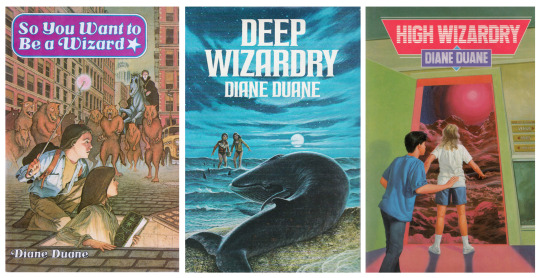
All of these editions are now difficult to find in good condition, especially SYWTBAW—which as a first book in a series by a new/untried author, perhaps understandably had a very small print run and was mostly sold to libraries. (The run might have been as small as 1500 copies. It's hard to tell now, as this wasn't data that was shared with authors in those days.) As a result, most copies of the Delacorte SYWTBAW hc are either very beat up, or (if signed and/or in good condition) relatively expensive. The Delacorte DW and HW hardcovers are a little easier to find, but not that much.
In the early 1990s there was a change in publishing direction at Dell shortly after HW came out. The publisher's interest had pivoted toward wanting more bestselling authors; so they jettisoned many then-new or midlist authors so as to be able to pay the best-selling authors more. (In this particular micro-bonfire of the vanities, Dell's stupidity in throwing Jane Yolen overboard, FFS, astounds me to this day.) So though the books continued to be published as paperbacks at other Dell imprints (Laurel-Leaf, Yearling) through the mid-1990s, that was the end of the Dell hardcovers.
The next hardcover publication was therefore in 1990, from GuildAmerica / SF Book Club. Support Your Local Wizard contains SYWTBAW, DW and HW, and was a Book Club bestseller: it sold a quarter million copies and set a record as their most popular new-member-requested book that lasted until they went out of business. As a result, there are a lot of these books around.
Also in plentiful supply is The Young Wizards, which SFBC Fantasy published in 2001. (NB that a lot of sources list this as being a 1984 book, which is incorrect. As it also contains, besides the first three, A Wizard Abroad and The Wizard's Dilemma, this makes it impossible to have been published any sooner than 2001.)
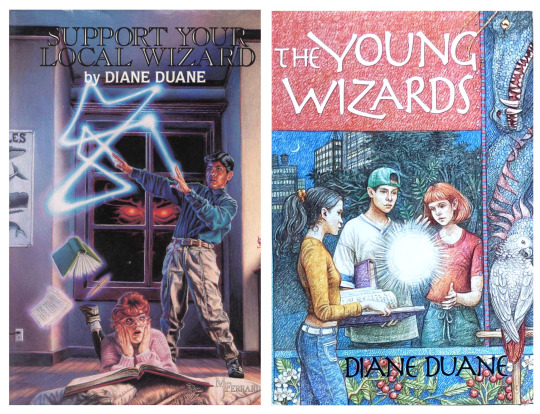
Anyway, after that, things get a bit simpler. In the mid 1990s the series was picked up by Houghton Mifflin Harcourt / Harcourt Trade Publishers' new YA imprint Magic Carpet Books, which began republishing earlier works. Possibly the oddest of these was a small-format (mmpb-sized) hc of SYWTBAW, which turns up here and there used. (I really need to ask Jane some time what the heck the thinking was on this book...)
...Anyway. A Wizard Abroad had until then been published only in the UK (in a mass-market mmpb from Transworld/Corgi); its first hardcover came out from the SF Book Club/GuildAmerica in 1993, Dell having passed on acquiring it. (The cover on this one was done by the fabulous David Cherry, artist and brother of my old colleague C. J. Cherryh.) Harcourt did another of the unusual small-format hardcovers, this time of AWAb, in 1997—testing the waters, I think. Then, when that sold strongly, they went straight to full-size hardcovers with The Wizard's Dilemma (with art from then until now being done by Cliff Nielsen) and have stayed with that format since.
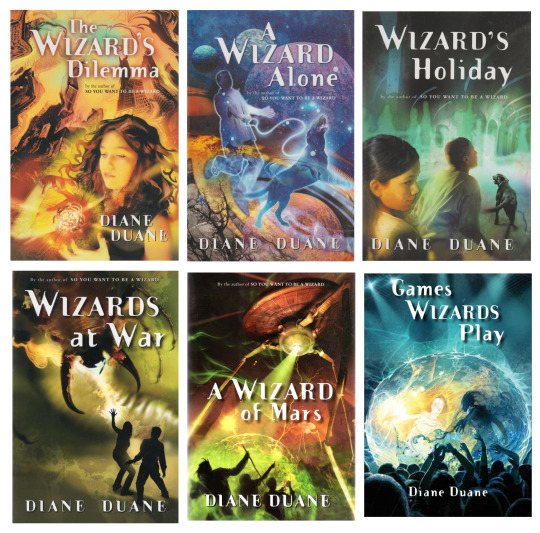
Harcourt also did a lovely 25th anniversary hardcover edition of So You Want To Be A Wizard in 2003, which is easy to find inexpensively. I strongly suspect this republication trend would have continued with Deep Wizardry and High Wizardry when their respective anniversaries came around. But unfortunately the Magic Carpet program wound down soon afterwards, and the most recent hc volumes have been published simply as HMH, with no apparent interest at the publisher in going back to fill the holes in the hardcover backlist.
...So you can see, you've got kind of a mixed bag to deal with in terms of what you want. Availability has also been something of an issue, as the books are considered pretty deep backlist by Harcourt's current owner (HarperCollins), and warehouse supplies of some books in the series have been iffy.
So. The simplest I can make things for you is to help you avoid dealing with large corporate warehouses (because when some of these hc editions were preparing to go out of print, whenever possible I bought up the remaining stock to spare it from being pulped). Signed Books Direct—by which I mean the Ikea shelves out back in our boot room—has ample mint-condition supplies of many of the Harcourt hardcovers (though not Games Wizards Play, unfortunately: we've run out of those). Ignore the site’s front page inventory, which needs to be updated. Instead, just drop an email to the SBD email address and query me about what you're looking for.
HTH!
126 notes
·
View notes
Text
A Catalog of Collections - Reading Batman from 1986-2011 in Trade/Omnibus Formats
So here’s the thing about Batman: he’s got a lot of comics published about him. Like, a lot. DC Comics has been publishing a comic under the Batman title continuously since 1940, and that doesn’t even begin to touch his history in the Detective Comics title (published since 1939) or any of the many other stories that bear his name.
If you want to read Batman comics, it can be intimidating! I get it. That’s a lot of single comic issues to find and read. This is an updated guide to a list I made a bit over a year ago, which aims to catalog collections of the Batman title published between the Crisis on Infinite Earths story (which concluded in 1986) and Flashpoint (which was in 2011). This era is called, with some interchangeability, “New Earth,” “post-Crisis,” “pre-reboot,” or “pre-Flashpoint.”
You may look at that and have a few questions. Just the Batman title? And why only a 25 year span? The first answer is practicality. If I tried to list out every Batman story, we’d be here forever. We’re going to start with his main, self-titled comic and move from there. As for the time period, Crisis on Infinite Earths was a company-wide effort to give characters new histories and stories. This ushered in a new status quo for Batman that set the stage for some of his most iconic stories. Flashpoint was another one of these company-wide reboots, completely resetting Batman (and the whole DC universe) in The New 52. A lot of what we now consider “classic” Batman stories come from this period in between the two resets. This is not to disparage current comics, but merely to comment on the fact that once an era has ended it’s easier to evaluate… and to collect into trade.
Because the (subjective) truth is that collections make it easier to read comics. Why track down five to twelve individual parts to a story when you can buy one book that puts it all together? This is doubly true if the story crosses over with other comics. The trouble is, some stories and their collections are quite famous, while others are less so. That is why this guide exists.
Ultimately, this catalog aims to help present the most complete list of collections of the Batman titles, published between 1986 and 2011, that I can provide. I subscribe to the fourth law of library science, to save the time of the reader, and I hope this list can help make the density of Batman more approachable.
The full list is currently available on my Dreamwidth. I'm currently fiddling with the format so that tumblr will let me post it here too.
32 notes
·
View notes
Text
So you want to know more about Big Barda
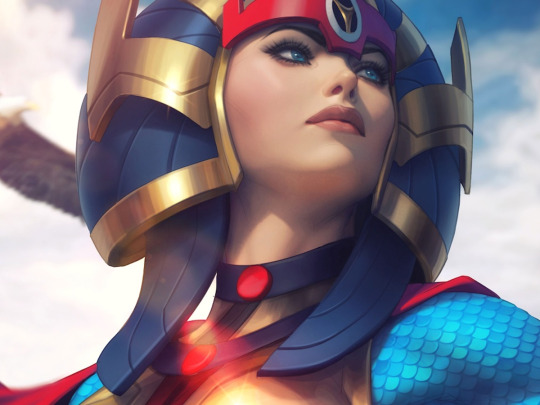
As Tumblr's resident expert on all things Barda, and as Kelly Thompson's Birds of Prey run brings far more attention to the character, I figured it was high time someone stepped in and gave the tumblr world a primer on DC's biggest and boldest heroine.
The Basics:
Introduced in Mister Miracle #4 by Jack Kirby, Big Barda was once the leader of Apokolips' premier death squad, the Female Furies. Trained from birth for a life of violence by Granny Goodness, Barda spent the first 250 years of her life as a living weapon. This all changed when she met Scott Free, a gentle Parademon-in-training with a mysterious past and a knack for escapes. Eventually, she and Scott both escaped to Earth, where they fell in love with both the Earth and each other. She's a lover, she's a fighter, she's a Pokémon card expert, but most of all, SHE BIG.
Barda's signature defining attribute is her raw strength. Her raw muscle allows her to keep up with heavy hitters like Wonder Woman. This isn't to suggest that she's a simple-minded brute, however-- Barda has centuries of military experience under her belt as leader of the Female Furies. She's mastered multiple weapons, including spears, swords, and her signature Mega-Rod.
Below are some reading recommendations for anyone interested in Big Barda:
Essential Runs:
Mister Miracle Vol. 1 #4-18 by Jack Kirby (1971-1974)
This was the run that introduced the world to Big Barda, as well as the Female Furies. If you want to know the basics of Barda, there's no better place to start. This run is collected in a trade, as well as a part in The Fourth World Omnibus Vol. 1.
(NOTE: Even though Barda doesn't appear until issue #4, I suggest you start with Issue #1. It'll help you get acquainted with the rest of the mythos.)
Justice League International #14-24 by Keith Giffen and J.M. DeMatteis (1988-1989)
Big Barda was on the JLI! She plays off the other characters as well as ever, and a lot of what's great about her in Jack Kirby's original run is still here! Definitely check this one out if you want to see her in another team setting. This has been collected in this omnibus.
(NOTE: Once again, I recommend you start from issue #1.)
Popular Runs:
Mister Miracle Vol. 4 #1-12 by Tom King and Mitch Gerads (2017-2018)
Yeah, I know.
Listen, Tom King is a writer with... idiosyncrasies to put it nicely. The characters in the periphery of his stories tend to act really out of character, and his dialogue can be clunky at times. That being said, The Scott/Barda dynamic in this book is excellent, and this book has some of the best art that the Fourth World has seen since the 80s. The series has been collected in a trade.
(NOTE: Did you know that the CIA has over 2003 files on Tom King? Look up "Tom King CIA 2003" for more info!)
Mister Miracle: The Great Escape by Varian Johnson and Daniel Isles (2022)
If you're at all interested in the idea of a Young Adult reimagining of Mister Miracle and Big Barda's origin story with an all-black cast, this book was made for you. It's a bit heavy on the YA tropes, but the Scott/Barda dynamic is really solid. It was released as a standalone graphic novel.
Birds of Prey Vol. 5 #1-??? by Kelly Thompson and Leonardo Romero (2023-)
Admit it, this is the reason you're here. The Cassandra Cain & Big Barda is so instantly iconic, I'm surprised no writer has paired them up sooner. It also helps that this book has the single best Barda look since Jack Kirby's original run. Plus, she gets to throw down with Wonder Woman! What's not to love? This run is still ongoing, but the first 6 issues should be getting a trade pretty soon.
(NOTE: I started writing this before BOP #8 dropped, I had no idea about that thing that happens in the newest issue.)
Stories to Avoid:
Action Comics #592-593 by John Byrne (1987)
This is not a comic book-- it's an infohazard designed to cause pain and suffering to anyone who knows of its existence. Its premise is vile and disrespectful on the surface, and it becomes more insidious when you learn the context of its creation. This pair of issues is profoundly evil, rivaling even Avengers #200 in terms of loathsomeness.
For those who dare to investigate this, Content Warnings for rape, mind control, and human trafficking.
Anyway, let's end on something a bit lighter, shall we?
Remember that Mister Miracle YA graphic novel I mentioned earlier? Barda is getting a graphic novel of her own this summer! It's not out at the time of writing, but the preview pages look promising!
Anyway, I hope you enjoyed that introduction to one of my favorite superheroes ever. Please get back to me on this, I have no one else to talk to about Fourth World stuff.
#big barda#barda free#dc comics#mister miracle#scott free#fourth world#new gods#justice league international#jli#birds of prey#jack kirby#keith giffen#j. m. dematteis#varian johnson#daniel isles#kelly thompson#leonardo romero#small bat#black bat#cassandra cain#wonder woman#diana prince#diana of themyscira
91 notes
·
View notes
Note
Do you know if the Impulse (1995) series has like big books like volumes where it will be a couple issues in one book. I don’t know if I’m explaining myself right😭. I can only find single issue ones. I just wanna know if they even made volumes of the series. Please help!
Hi! We do have a few trade paperback collections! Sadly it does not touch anywhere near the bulk of his series but it is at least something.
I'm going to list what we have by publication date.
1.) Impulse: Reckless Youth

This was published in 1997 and it contains his first few debut issues from The Flash (1987) and the first 6 issues from Impulse (1995). It also contains a lovely forward by Waid. Paper quality is bleh though. But everything is still in it's original print colors with no retouches.
2.) The Flash: Mercury Falling

This was published in 2009 and like the name suggests, contains the entire Mercury Falling arc. Sadly, no forward or special content exists for this and it was printed on gross paper, but it is still worth adding to your collection. Like Reckless Youth, colors are intact and true to first time printing. I also have no idea why they published this under THE FLASH.
3.) Flash/Impulse: Runs in the Family

This is the most recent compilation published in 2019 and it contains the first 12 issues of Impulse plus the supplementary issues of The Flash (1987) during the Dead Heat arc. It has been digitally retouched, but is on nice paper. Sadly, no special content.
You can get all of these online for pretty cheap despite no longer being in print.
I long for the day of an Omnibus collection but I highly doubt we will get this anytime soon....
20 notes
·
View notes
Text






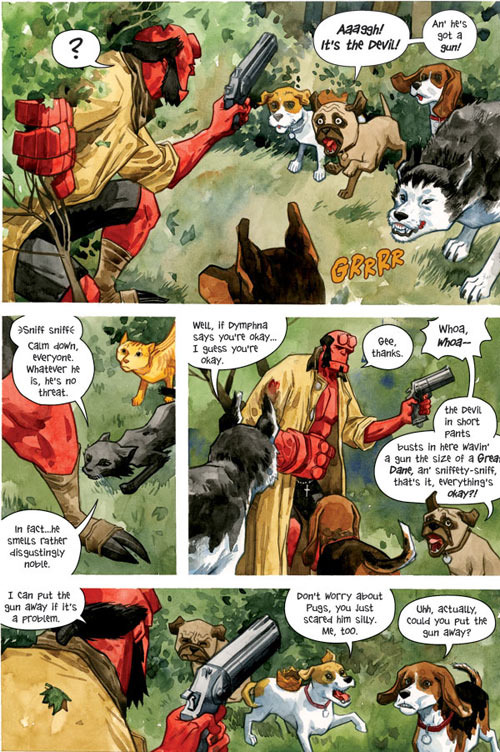





The BEASTS OF BURDEN OMNIBUS is now available at all booksellers, and preorders are going out. The Omnibus will be available at comic shops tomorrow. Published by @darkhorsecomics.
Thanks to everyone who supported the book by preordering through their comic shop or bookshop, thanks to everyone planning to pick the book up. And thanks to those out there trying the series for the first time.
The BEASTS OF BURDEN OMNIBUS collects all the material done in the series so far, almost 600 pages of stories and backmatter material (artist's layouts, covers, variant covers and other neat stuff). Includes the Eisner Award-winning stories, "The Unfamiliar", "Hunters and Gatherers" and "What The Cat Dragged In", as well as the one-shot Hellboy crossover (!).
Beasts of Burden has won eight Eisner Awards and a Harvey Award, and has been nominated for several other national/international comics accolades. For only $30 US you can get everything we've done so far in a big brick of a trade paperback.
Responsible parties are:
Jill Thompson (cocreator/illustrator), Benjamin Dewey (illustrator). Sarah Dyer (co-writer), Mike Mignola (Hellboy creator, aider and abettor), Nate Piekos (letterer), Jason Arthur (letterer) and Evan Dorkin (co-creator, writer, me).
#comics#dark horse comics#beasts of burden#beasts of burden comic#comic books#evan dorkin#sarah dyer#jill thompson#benjamin dewey#mike mignola#nate piekos#blambot#jason arthur#horror comics#horror#dogs#cats#dogs and cats#occult#supernatural#monsters#ghosts#witches#black cats#mythical creatures#fantasy#beasts of burden omnibus#hellboy#eisner award#harvey award
135 notes
·
View notes
Text
Okay, looking at the current push for reprints among the Batfam kids, what is available (trying to round this up):
Dick: Nightwing Compendium #1, with Nightwing vol 1, Nightwing vol 2 1-25 plus extras (out 7 May 2024); Nightwing Compendium #2, with Nightwing vol 2 26-59 plus extras (out 20 May 2025)
Jason: DC Finest: Batman - Year One and Two, despite the name, this covers Batman #404-414 and 'Tec #571-581, which contains his post-Crisis origin story and most of his 'Tec appearances as Robin (out 5 November 2024); Under the Red Hood Deluxe, with Batman #635-650 and Lost Days (out 5 September 2023); RHATO 2011 Omnibus, #0-27 (out 13 May 2025)
Tim: Robin Compendium #1, with Robin I, II & III, Robin vol 2 #1-5 and a LOT of assorted early material from Alan Grant (out 23 July 2024)
Steph: Batgirl: Stephanie Brown Vol 1, with Batgirl vol 3 #1-12 (out 22 October 2024)
Cass: DC Finest: Nobody Dies Tonight, with Batgirl vol 1 #7-27 (out 8 April 2025)
Damian: Batman and Robin by Peter J. Tomasi Omnibus, with Batman & Robin vol 1 #22-24, Batman & Robin vol 2 #0-40 and extras (out 17 January 2023); Batman & Robin vol 1: Batman Reborn, with B&R vol 1 #1-6 (out 25 April 2023); Batman & Robin vol 2: Batman v Robin, with B&R vol 1 #7-12 (out 29 April 2025); Robin: Son of Batman by Patrick Gleason #1-13 (out 5 November 2024)
Barbara: Simone and Bedard's BOP runs have just finished a run of reprints in 2023 and are looping around to redo it again right now: Murder & Mystery BOP #56-67 (out 22 October 2024); Hero Hunters BOP #68-80 (out 6 May 2025); Fighters By Trade #81-91 (most recent 21 September 2021, look out for this one again); Progeny BOP #92-103 (out 26 March 2024); Whitewater #104-112 (out 5 July 2022); and The End of the Beginning #113-127 (out 21 February 2023); the Batgirl vol 4 run had omnis in 2021 and 2022 covering the whole run.
Helena B: the same BOP reprints as Barbara, also has Robin III in Robin Compendium #1.
Maps: Gotham Academy vol 1 #1-18 (out 9 May 2023)
Duke: All-Star Batman by Scott Snyder, with #1-14 (out 10 September 2024)
Jean-Paul: okay JPV doesn't have anything for Azrael. But Knightfall gets reprints every 5 years like clockwork and we just had a 2023 omnibus, so I think that counts for him.
There is a massive push to get everyone's major solos/personal teams into print at the moment, to my eye, with the big gaps being actually getting Red Robin back into print, finally collecting Huntress vol 1 for Helena Bertinelli, and then like...actually continuing the reprints in the big projects (Robin, early BOP).
26 notes
·
View notes
Text
Some U.S. lawmakers remain determined to claw back some of the constitutional trade authority that Congress began handing the president 90 years ago, introducing a spate of bills and resolutions in both houses in an effort to curb U.S. President Donald Trump’s ability to single-handedly upend the U.S. and global economies.
Several Republican senators have joined their Democratic colleagues to try to restore some of the congressional authority over tariffs that is enshrined in the Constitution.
“So the good news is that our colleagues are waking up to the fact that the president went too far and that we need to have a discussion,” said Democratic Sen. Maria Cantwell, who has seven Republican co-sponsors on her bill—introduced with Sen. Chuck Grassley—to allow Congress to review any tariff actions taken by the executive branch.
However, House Republicans are not breaking ranks with the White House, and the flurry of lower-chamber bills and resolutions meant to curb Trump’s tariffs has been stymied by Republican procedural gimmicks.
Since Trump, after taking office a second time, has ratcheted up his trade wars, there has been a bevy of congressional efforts targeting the national emergency that Trump invoked to levy tariffs on Canada, Mexico, and China; the national emergency he cited to put tariffs on nearly the whole world; his expansive use of national-security justifications to shield U.S. steel and aluminum producers; and even presidential authority to set tariffs at all.
“Donald Trump’s aimless, chaotic tariff spree has proven beyond a doubt that Congress has given far too much of its constitutional power over international trade to the executive branch,” said Sen. Ron Wyden, the ranking member of the Senate Finance Committee, in a hearing with Trump’s trade representative, Jamieson Greer, on Tuesday. “It is time to take that power back,” Wyden added.
Wyden has released a resolution that would terminate the national security emergency that Trump declared to justify the global tariffs, and the senator has redoubled his desire to rein in Trump even after the administration’s change of heart on Wednesday.
One reason why Congress remains concerned despite Trump’s seeming walk-back on Wednesday from the most severe of his tariff plans, leaving just the highest duty rates in more than a century, is that markets remain deeply gloomy. U.S. stock and bond markets were back in the doldrums on Thursday, and crude oil, fearing a broad economic slowdown, is again plunging. Many congressional questions fired at Greer over two days of testimony centered on the economic pain— especially in retirement accounts—suffered by ordinary Americans, in addition to rising costs for households.
Even if continued market and economic turmoil does change the calculus enough in the House to secure a floor vote or passage of any of the tariff-related bills and resolutions, overcoming the nearly inevitable presidential veto will be a lot harder—unless the economic damage from Trump’s trade wars becomes more apparent in months to come. As part of the Wednesday “pause,” Trump raised tariff rates on China to stratospheric levels, forcing a decoupling of the world’s largest and second-largest economies that will, if continued, have ripple effects around the globe.
The whole reason that Trump’s effort to top the notorious Smoot-Hawley tariffs of the early 1930s is spurring Congress into action is because it was the corrupt, log-rolling nature of congressional deliberation behind that snowballing tariff omnibus that drove lawmakers to hand the trade keys to the White House in the first place. Bypassing Congress, it was argued at the time, would avoid narrow sectoral interests and allow for a deliberative tariff and trade policy taken in the national interest.
The first big congressional delegation of its trade powers came in 1934. Three more major transfers of trade authority followed, in 1962, 1974, and 1977, along with plenty of minor delegations of trade oversight. Trump has especially leaned on the last three trade acts to justify his first- and second-term tariffs on steel, cars, Canada, Mexico, China, and everyone else. The 1977 International Economic Powers Act (IEEPA) has become a particular go-to for this Trump administration, though tariffs had never been levied under the Carter-era legislation before this year.
That reliance on a questionable “national emergency”—which is driving many of the narrower congressional bills and resolutions—is also leading to challenges in court. As a rule, though IEEPA’s use as a lever for tariffs is novel, courts in the past have given the executive wide deference on national security matters and IEEPA invocations, though government arguments in court will get more challenging now that Trump has decided that the national emergency was not so bad that he couldn’t suspend it for three months on a whim.
At any rate, the reason that some in Congress are intensifying the timid efforts made during the first Trump term to wrest back their authority over trade is because in a few short weeks, Trump 2.0 has shown himself to be much more unbridled and destructive than even during his first term.
The ad hoc nature of the administration’s policymaking on trade—from the risible formulation of the so-called reciprocal tariffs to the sudden and unforeseen reversal of that policy in the middle of testimony by the U.S. trade representative—has convinced many that delegating trade authority to this particular president may be a dangerous dereliction of duty.
“Do you think Congress should be left out?” Sen. Bernie Sanders asked Greer during Tuesday’s testimony. “Do you have any concerns about all that power in the hands of the president?”
9 notes
·
View notes
Text



🐻❄ His Dark Materials Omnibus 🐻❄
By Philip Pullman. This was the 2nd part to my trade with @floralbearies . She let me know a long time ago that this is one of her all time favorite series so I knew I had to do it for her. The problem was how do I do it justice? Again there are so many wonderful covers out there already for this series. I decided on doing something slightly religious and slightly fantasy.
I'm happy with the way it turned out!
#reboundbook#books#rebinding#book rebinding#booklr#book#bookish#bookrebind#rebound#book series#philip pullman#his dark materials#the golden compass#the amber spyglass#the subtle knife
7 notes
·
View notes
Note
heyy, i was thinking to get some good nightwing/batman comics, like ones w good art that i can show off to my friends but also good story lines?
a friend suggested that i ask you, as you probably know more about this topic and own some physical copies yourself.
thanks if you answer and have a wonderful day!
So this was a tricky if only because hitting that trifecta of art, story, and easily obtainable as a collected edition can be hard, but I'll do my best to give you some recommendations here. I would also say that a lot of my favorite Dick and Bruce moments are less storylines, and more single moments or issues. (Unless you want Nightwing OR Batman comics, in which case I will try to give you recs for both.) This is going to be mostly post-crisis stuff because that's what I've read the most of.
The Bruce and Dick storyline that first comes to mind as hitting most of your points is actually Robin: Year One which does not feature Nightwing, but does have a good story, a fun, more simplistic art style, and has been collected multiple times so it shouldn't be too tricky to find.
I believe it's getting a box set soon with Nightwing: Year One and Batgirl: Year One soon which should also make it easier to obtain.
Nightwing: Year One on the other hand, does feature Nightwing and Batman focusing on Dick's transition from Robin to Nightwing. As such, it doesn't require a lot of previous reading, but story-wise it's, hmmm, not my favorite take. Additionally, it has Scott McDaniel on the art which is a bit of an acquired taste and if you're trying to get your friends into comics, might be a bit of a turn off.
Overall: Your mileage may vary.
Other recommendations for Nightwing and Batman (together):
Bruce Wayne: Muderer/Fugitive -- This is a larger event that chronicles that one time Bruce Wayne got framed for murder. It features the entire ensemble of Bat characters (more or less) reacting/getting involved, but Nightwing plays a significant role (alongside Bruce obviously). Also Batman #600 which is part of the event is probably one of the THE Bruce and Dick issues to me. Art wise, it's a crossover event so there are multiple artists with multiple art styles (one of which is Scott McDaniel) so I can't really give a definitive answer, but it's probably pretty for the course for early 2000s comics. This event has been collected a few times and there's an omnibus announced as coming out at the end of this year. Omnibuses do make for less convenient reading and they tend to be more expensive, but in terms of collecting convenience and also getting lots of comics for your money, they're pretty good. Maybe see if there are any omnis at local bookstores or in your library system just to see if physically it's something you're interested in owning. I personally do have some omnis for the collecting convenience, but I prefer trades because their easier to read.
Batman: Gotham Knights: Transferrence -- In a similar vein to Bruce Wayne: Murderer/Fugitive, this is a ensemble book focusing on Batman's relationships with his extended cast. It does have several good stories featuring Nightwing in it. This probably would work as a good book to share with newer readers. I wouldn't say the art is standout, but it gets the job done and won't burn your eyes out or anything.
Recommendations for Nightwing:
Tomasi's run on Nightwing is a fan favorite (I too enjoyed it) and it was collected in the Nightwing by Peter J. Tomasi trade fairly recently (2020), however due to it being a fan favorite, I think it's in the category of you'll have trouble tracking it down.
A solid chunk of Dixon's run on Nightwing was also recently collected in the Nightwing: A Knight in Blüdhaven Compendium which I believe came out in May which should make it easy to get your hands on. It collects the first 25 issues of his solo, plus some other stuff. Dixon's run is considered to be foundational, but personally while there are some stories I liked in there, Dixon's Nightwing is not my favorite. Also, the majority of it has Scott McDaniel art which is, as stated previously, an acquired taste. As a compendium, it's chunkier sized like an omni, but paperback which makes it cheaper than an omni, but still a little chunkier than convenient for reading. Very good bang for your buck in terms of the number of comics it collects though. I'll put this also under, your mileage may vary. I'd recommend trying to read some before just buying to see how you like it.
Recommendations for Batman:
In terms of solid comic that can be read without context, and has been collected a million times so you should be able to find it easily, I'll recommend The Long Halloween. This follows Bruce earlier in his Batman career in a case that brings him in contact with most of his rogue's gallery. It's a fun read. Tim Sales' art is stylized in a way that I really liked. I have not read Dark Victory, which is the sequel to this story, but I know that it features Dick Grayson as Robin.
I also really liked Paul Dini's detective comics run, but it's looking like that's only collected in 15 year old trades and an omnibus (released 2020 so you should be able to find it if you're interested), but see my note about Omnis.
In Conclusion:
My biggest piece of advice for buying collected editions is to buy comics you know you'll like. If there's a storyline you really like, check if it's collected! If you're getting started, I recommend checking if your library has comics. In my experience tend to ether be in the non-fiction section (I know, but it has to do with the dewey decimal system) or in the teen section. Mine has a really good comics selection, so if you have access to something similar, flip through them and see what looks cool!
Newer comics also tend to be easier to find collected editions for just because of how DC's business model has evolved, so if anyone has recommendations for newer comics, please feel free to add them on!
(Art examples below the cut.)
Robin: Year One

Nightwing: Year One:

Gotham Knights:

The Long Halloween:

#letters to the editor#1vyyxo#dc#batman#nightwing#bruce wayne#dick grayson#bats + birds + affiliated#last of the flying graysons#carthago delenda est
27 notes
·
View notes
Note
Hey, do you have a reading list for batman: nml. I'm so afraid of it, but I think it's time for me to read it 🙂↕️.
YEAHHHH im so proud of you anon. nml is long & intimidating but it is also sooo worth it and is so foundational to the batman mythos.
to start, no man’s land has a few different parts which i would highly recommend reading all of. the saga goes cataclysm -> road to no man’s land volumes 1 & 2 -> no man’s land. cataclysm is 18 issues where the quake actually happens, rtnml is kinda prequel & setup, and then the brunt of the story happens in nml proper. a lot of people kinda just skip past road to no man’s land or don’t know they’re supposed to read it at all which i think ISNT the way to go lmaoo there is some very important context and stories in there.
so the problem with finding good no man’s land reading lists is that most of them are not accurate💀 like there is just so much of it that a lot of issues slip through the cracks and it’s hard to find a truly complete thorough guide. honestly my best recommendation might be to look for the omnibus trades. your library might have them, or you can always just look up the omnibuses on rco.
cataclysm is an easy simple 18 issues found here, thank you to locg:

for the rest of nml there is a list here, which looks pretty accurate from a first glance EXCEPT for the road to no man’s land list which leaves some things out, volumes 1&2 of rtnml should be this at least according to locg


this site breaks down the issues by omnibuses which is helpful.
mem @havendance has a very helpful guide to important nml issues here along with some commentary, and also has a timeline of the whole event here which is very nice to reference.
sorry for throwing a bunch of different options at you but yeah as I said nml is TRICKY to find complete lists for. I wish you sooo much luck in your journey! and if anyone has a more accurate guide please feel free to chime in lol
#ask#no man’s land#sorry this is all over the place there is simply So Much#safest bet would probably be to just read through the omnibuses
26 notes
·
View notes